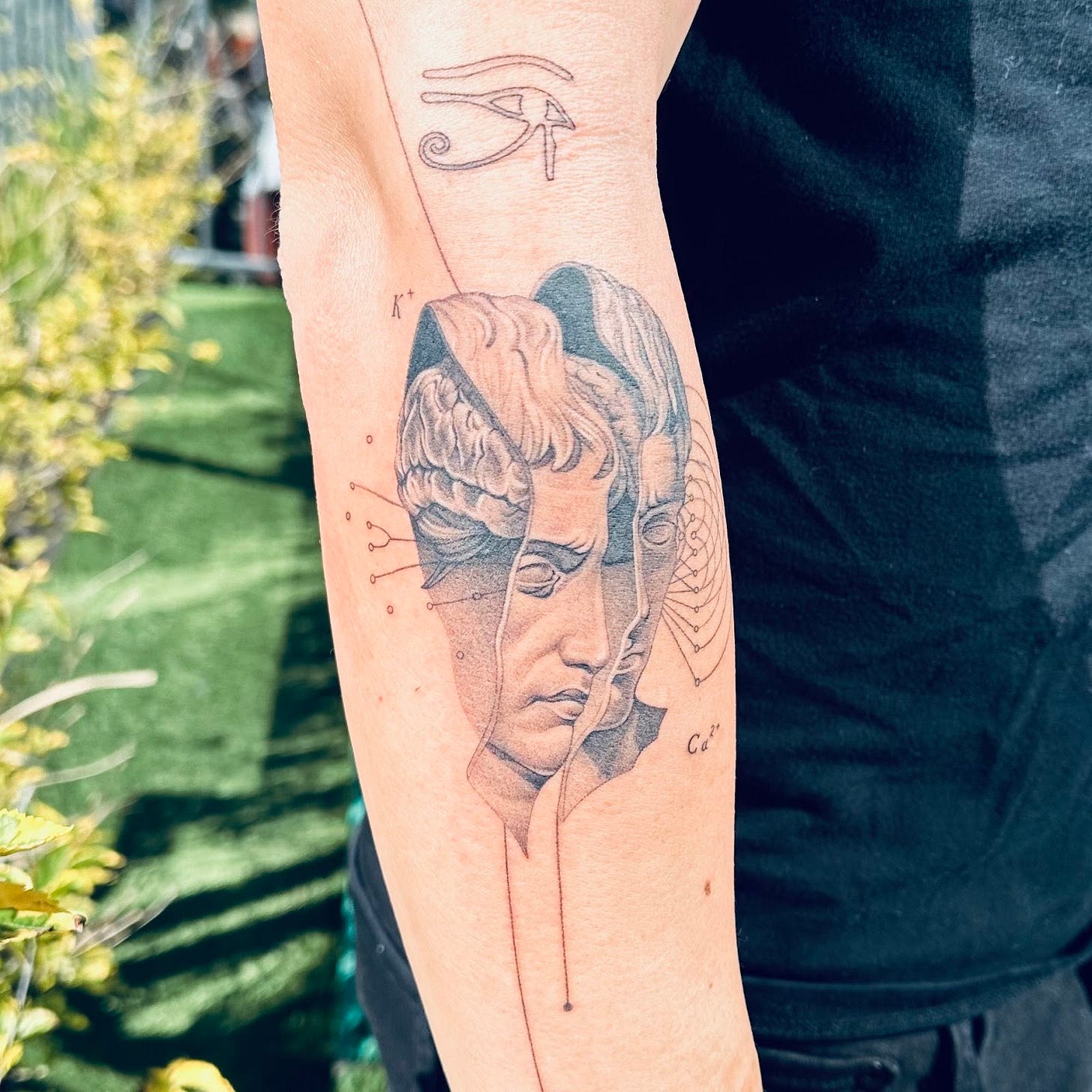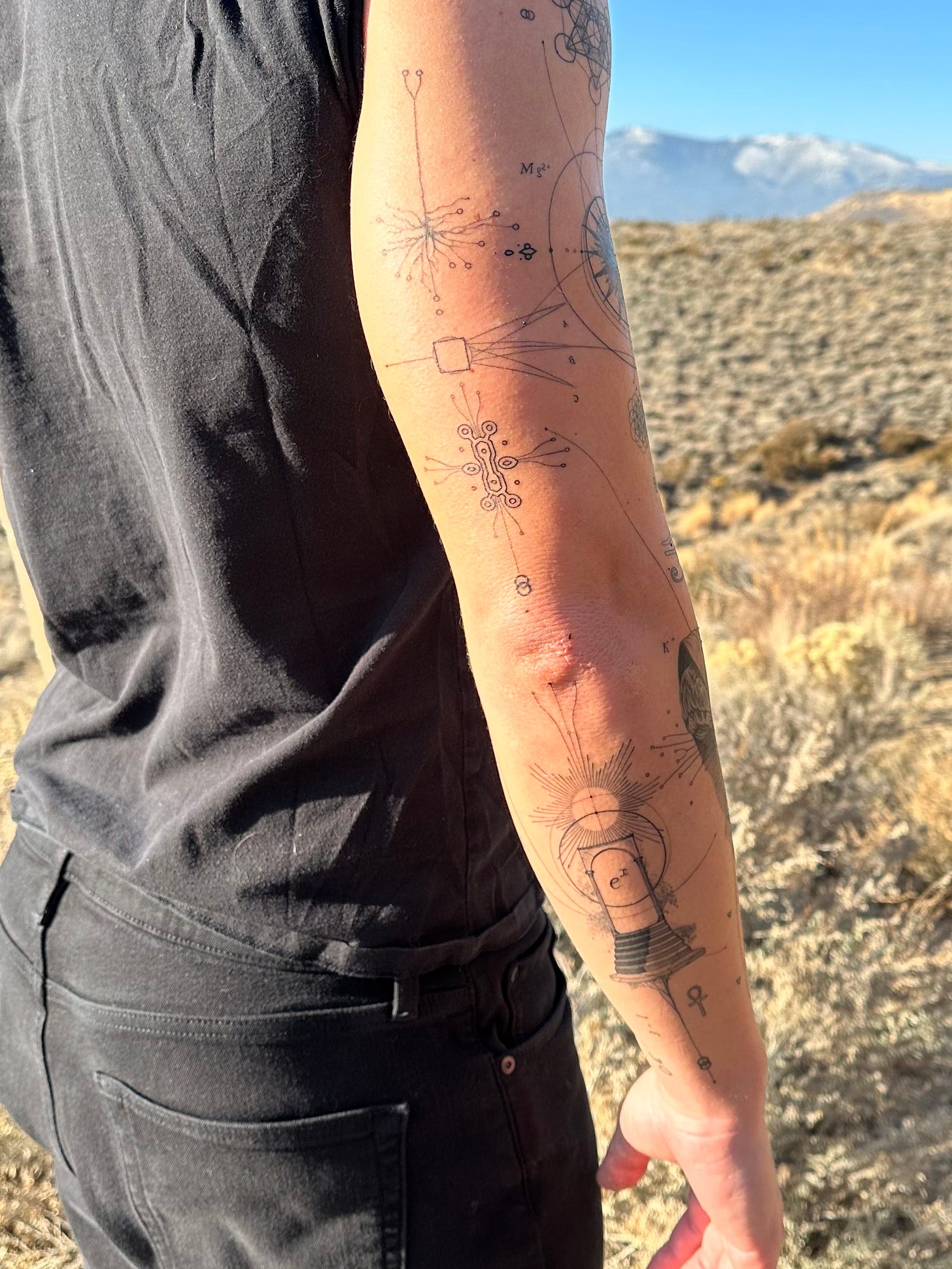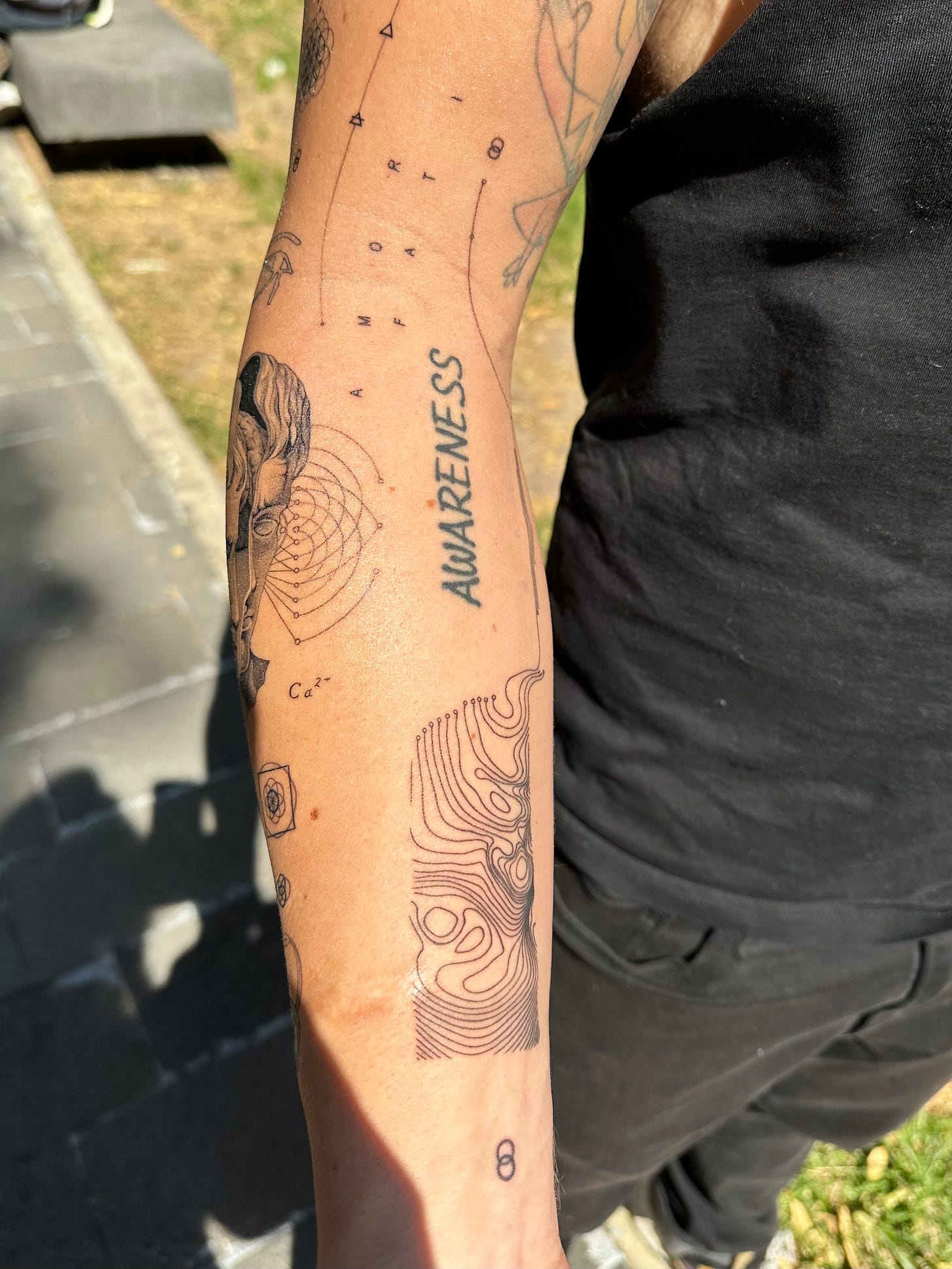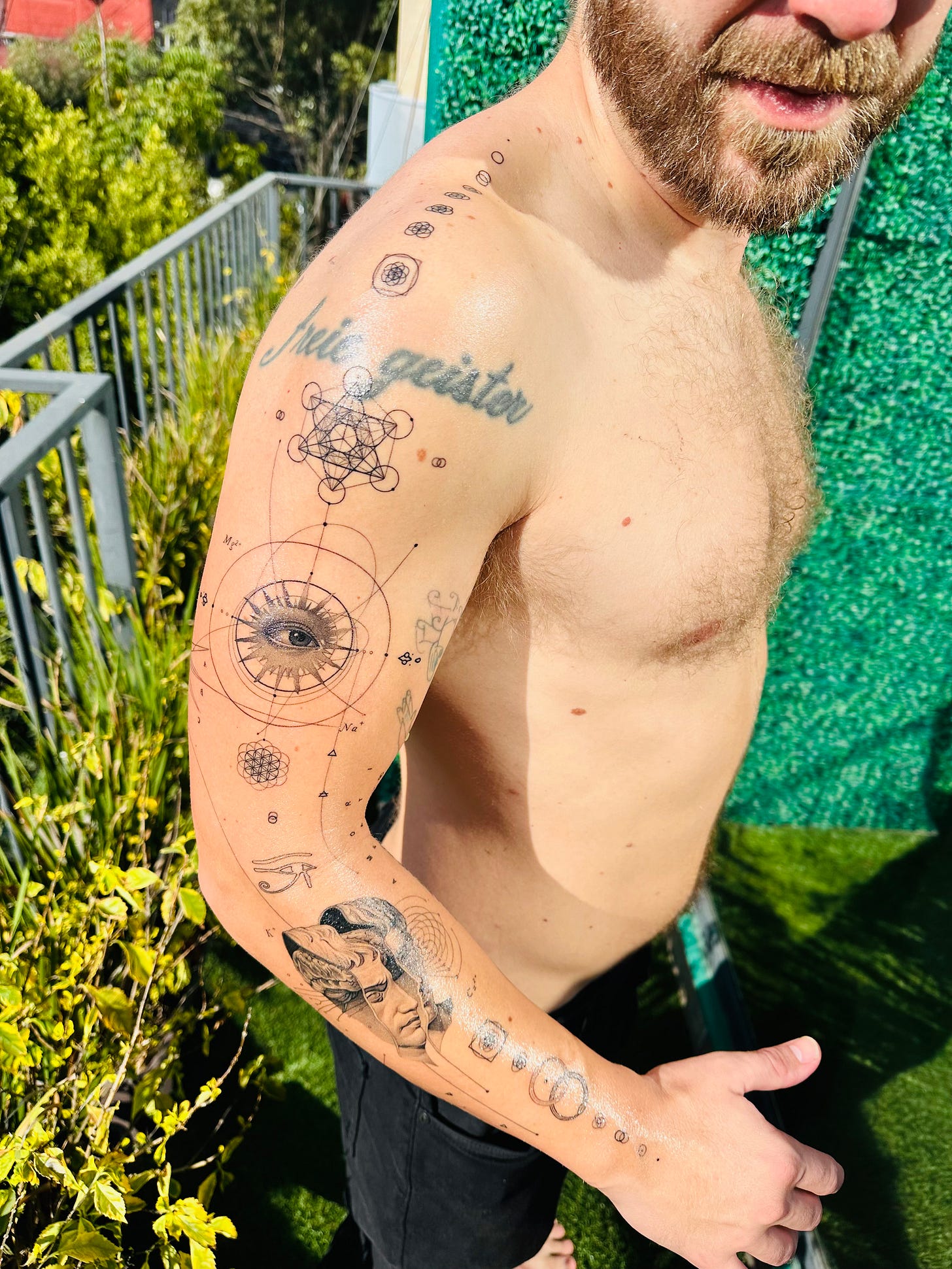A Living Canvas for Geek Art
My new tattoo sleeve integrating philosophy, mathematics, and neuroscience
Note: I’m switching to Substack from my self-hosted blog. Happy reading!
I’m happy to announce that my all time favorite tattoo is now on my own body. This turns my right arm into a composition integrating my primary interests: philosophy, mathematics, and neuroscience. From neural networks and probabilities to ancient Egyptian symbolism and fractal geometry, this bad boy has it all. So buckle up for a walk through the six days of tattooing and tacos I just wrapped up in Mexico City this past week with the legendary tattoo artist Rodrigo Salcedo Velarca.
An overview of the whole composition
Integration of the Themes
“Wholeness is not achieved by cutting off a portion of one’s being, but by integration of the contraries.” - Carl Jung
The centerpiece of the composition integrates these three themes with a marble head split in pieces revealing an anatomical brain within. On one side of the marble head and brain is a biological neural network. On the other side is an artificial neural network, that crazy invention that won the Nobel Prize this year and allows for everything from recognizing puppies in photographs to chatGPT. The thing that’s endlessly exciting about artificial neural networks is what’s called the “universal approximation theorem” that states that artificial neural networks with certain characteristics can theoretically represent any function, or any relationship between inputs and outputs. Want to map an input question in chatGPT to an output response? There’s a neural network for that. Want to map stock market data to the migration patterns of Canadian geese? Theoretically, a neural network can map that too. And, of course, a biological neural network is responsible for everything you’ve experienced in your life to date. So this centerpiece integrates the themes with the marble head alluding to Greek philosophy, mathematics through an artificial neural network, and neuroscience through a biological neural network.
The centerpiece before additional elements were added
Philosophy
“My formula for greatness in a human being is amor fati: that one wants nothing to be different, not forward, not backward, not in all eternity. Not merely bear what is necessary, still less conceal it—all idealism is mendacity in the face of what is necessary—but love it.” - Friedrich Nietzsche
The first theme is philosophy organized around one of my all time favorite concepts in philosophy: the “sacred yes.” This originates from the 19th century philosopher Friedrich Nietzsche. The sacred yes is his solution to a thought experiment of “the eternal return of the same.” If you were to relive the same experience day after day and year after year, could you affirm or say yes to that experience? This is a test of the affirmation of life despite adversity, monotony, control, etc. He calls this approach amor fati or the Latin for “love of fate.” This theme represents a general orientation towards life as one of affirmation.
This idea is represented by a staircase leading upwards to an open door. In that door is the mathematical function for an exponential, or ex. Graph this and it plots a hockey stick that more than doubles at each unit increase of x. Euler’s number, or e, is itself interesting as it’s a widespread mathematical constant that exists in calculus in the way that pi exists in geometry: it’s a constant that’s necessary for making that branch of mathematics work. One might think of a constant as what was fated by the initial construction of the physical universe to which all observable phenomena must adhere. Next to the staircase is the Egyptian Ankh (☥) that symbolizes life and the eternal. Like all good symbols, it’s rife with meaning including the integration of masculine and feminine. Also part of the tattoo are the words “amor fati.” Connected above the staircase is a symbol for expansion. This came from Rodrigo’s work creating a lexicon of various abstract, hieroglyphic-like symbols. One evening over dinner I pulled this from his deck of custom made tarot cards and not only did the symbol fit the piece but adding a component pulled at random to a permanent tattoo perfectly fit the theme of the love of fate.
A neuron and reversed optics diagram (described below). Also the symbol for expansion and stairs
With each of the three themes, there’s related symbolism. For the theme of philosophy, the symbolism is the elemental triangles. These represent earth, wind, fire, and water. The balance between symbolic and literal symbolism throughout the composition reflects the dualism between mind and brain or sacred and profane. This is one of the key dualities throughout philosophy: how does the subjective experience of the world interact with the physical world? Do the actions of neurons create conscious experience or does consciousness dictate material changes in the brain? This is a paradox for the ages with countless volumes written on it. As with many polarities and big questions, it’s less a question to be solved than, to paraphrase the poet Rilke, a question to be lived. This theme of duality is seen elsewhere in the tattoo with two circles or a combined circle and square.
Mathematics
“To those who do not know mathematics it is difficult to get across a real feeling as to the beauty, the deepest beauty, of nature ... If you want to learn about nature, to appreciate nature, it is necessary to understand the language that she speaks in.” - Richard Feynman
The second theme of the tattoo is mathematics, or the world perceived objectively. What drew me to mathematics initially was the idea that human cognition is full of biases. Left unattended, our default is to understand the world conventionally, emotionally, egotistically, linearly, locally, etc. Through a more rigorous understanding of mathematics, you can start to move outside of these biases. This central idea fueled my interest in science, statistics, neuroscience, and the list goes on. Mathematics is the language of nature and the foundation of understanding the world outside of human subjectivity.
This theme is represented with a gradient. This concept in machine learning can be visualized like a topological map showing the peaks and valleys of a given terrain. Viewed in one direction the tattoo looks like an abstract topological map but from the other direction it looks like a portion of a face. In machine learning, you’re using mathematics to try to find the global optimum, which can be thought of as the highest or lowest point within a topology. This is why these approaches are sometimes called “hill-climbing algorithms” as they iteratively work through a given space in order to find the optimum as a mountaineer would climb a mountain. This optimum can be the highest reward or lowest error between a model’s prediction and the true values. The most common solution for this is called “gradient descent” where you update your model of a given space at each iteration by taking a step toward the optimum. This is similar to how humans find their own optima in life, moving through the world and taking steps in the direction that best optimizes their desired outcomes. This piece includes the formula for “gradient ascent,” which looks within a given space for the maximum.
A topological map symbolizing a gradient
The second component of the mathematics theme is emergent phenomena. These are complex patterns that arise from simpler elements that are not easily predictable from the individual components. Stock market dynamics, flocking behavior of animals, and protein folding are a few examples of emergent phenomena. This composition represents this through the movement from mathematical simplicity to complexity and then back to simplicity, starting and ending with a single point on my hand and on the base of my neck. This movement of emergence and dissipation follows the evolution of sacred geometry:
Single Point: a point with no dimensions (no length, width, or height) as the starting point for all geometry
First Circle: a circle made by the set of all points in a plane that are a given distance from the central point
Vesica Piscis: two circles where the intersection of each circle is the center point of the other one
Seed of Life: from the Vesica Piscis, you draw new circles around the initial circle with the center of each new circle on each of the intersections between a new circle and the initial circle. This structure can be found throughout nature, especially in cellular division and embryonic development
Flower of Life: continue this pattern by tessellating new circles at intersection points for a total of 19 circles
Metatron's Cube: this adds straight lines between every center point of every circle in the Flower of Life to one another. Notably, this figure contains all five of the platonic solids, which are shapes like the cube and tetrahedron that all exist within the Metatron’s cube. When you place a Platonic solid in Metatron’s cube, it touches on all sides
Also to the theme of mathematics is a representation of the second law of thermodynamics. This speaks to the fundamental direction of energy moving towards higher entropy. Natural processes move towards a state of maximum entropy or disorder. This is the irreversible movement of things such as food coloring dispersing in a glass of water. The food coloring will never be concentrated again unless significant energy is applied, which itself creates more entropy. The second law of thermodynamics is often referred to as the “arrow of time.” It is represented with the sun and moon with a long line with an arrowhead at the end. Interestingly, life is a local decrease of entropy (e.g. the order within a living cell) that increases entropy globally since it consumes energy and releases heat and waste. The supposed end of the universe is the “heat death” where maximum entropy is attained and energy is uniformly distributed. Theoretically, this would happen ten to the power of one hundred years from now.
The mathematical symbolism includes a small θ (theta) on my right hand representing the parameters that a machine learning model learns. I debated also getting an ε (epsilon) on my hand as well which stands for the irreducible noise and error in any system, but I decided against it to keep it minimal. I think of this symbol as a “shibboleth.” This Hebrew term is for a part of a plant and has a difficult pronunciation, therefore acting to distinguish a given person based on their pronunciation. Similar concepts might be Americans pronouncing Spanish or French R’s or a German umlaut: non-native speakers will never really get these things right. So this small component was meant in part as a reminder to demarcate signal from noise but also as a distinguishing element for those who are curious about the human experience.
I also have a few other elements like P(A|B) which, pronounced the “probability of A given B,” is the beginning of Bayes Theorem that, in probability theory, pertains to how you update a belief given new information. There’s also a σ (sigma) representing the spread of a dataset around its mean. Finally, there’s a 1 - ϵ which speaks to the explore versus exploit tradeoff. This concept is throughout machine learning and in the way we run our lives as the tradeoff between how much we do novel things to gain more information (like try a new restaurant) versus act on information we already know (like going back to a restaurant we know we like). This tradeoff is essential to decision-making and one of the main algorithms we live by daily to find our optima.
Neuroscience
“The foundational equations of physics, the periodic table of chemical elements, the endless ATGC chatter of your genes–none of these express anything about consciousness. Yet you awaken each morning to a world in which you see, hear, feel, and think. Experience is the only way you know about the world.” - Christof Koch
The final theme is neuroscience, or the world perceived subjectively. This is a nod to my interest in meditation, consciousness, and the brain. The brain is the most complex thing in the known universe with ~86 billion neurons and ~100 trillion synapses (or connections to other neurons), which is several hundred times more than the stars in our galaxy. This means that a given neuron forms from one thousand to one hundred thousand connections with other neurons. Imagine being in the largest stadium you’ve ever been to, standing in the center of it, and having lines extending from you to each seat in that stadium. That’s how connected a single neuron can be. And a neuron is not a neuron: there are upwards of a thousand or more cell types in the brain including many many different types of neurons. Wowzers.
This theme is represented by a sun surrounded by the rotation of planets. Inside of the sun is a human eye. I’ve been joking that the eye is so realistic that you can see it blink. The sun here is analogous to conscious awareness illuminating its surroundings. The sun is a symbol of excess, of the free sharing of energy without receiving energy from its surroundings that is the condition under which all known life exists. The profound and very strange philosophy of Georges Bataille characterizes this as the sun’s “squandering without reciprocation.”
Nearing completion with the eye of awareness, centerpiece, and sacred geometry sequence
Also in this theme is the inverse of the normal diagram of light entering the eye, symbolizing the effect of the act of perceiving on reality. This can be thought of as the observer effect in quantum mechanics where the observer changes reality or, at a more basic level, the way that our prior concepts influence the way the world appears. Finally, there’s a small neuron. This was a creative interpretation because, well, a hundred thousand connections felt a tad excessive. Visually, there’s overlap with this design and that of a computer chip.
The symbolism for the neuroscience theme is the different ions necessary for brain function peppered throughout the composition like calcium (Ca2+) and potassium (K+). This makes the connection between the symbolism of the elements with earth, wind, fire, and water back to the literal elements. There’s also an Eye of Horus. This ancient Egyptian symbol was for protection, restoration, and the cyclical nature of life. Most interesting for me, however, is that some speculate that it’s actually a map to the pineal gland in the brain, which is responsible for regulating sleep, circadian rhythms, and influencing certain hormones. Regardless of the factual accuracy of this claim, it’s another overlay of the dualism between the literal and the symbolic, brain and mind.
One final symbol is the ouroborus, or the snake eating its own tail. Dating back to ancient Egypt, the first known depiction was on King Tut’s tomb in the 14th century BCE. This symbol is pervasive across many cultures but one of the most aligned interpretations comes from Carl Jung who interprets the ouroborus as an archetype representing the human psyche’s process of individuation, or integrating conscious and unconscious elements to achieve self-realization. It can also be seen as a symbol of infinity and wholeness. It’s depicted on my arm as two interconnected snakes–one lighter and one darker–as a reference to duality.
Wrapping Up
So there it is, a synthesis of my favorite things. Except tacos. Those will have to come in a future addition. This was one of the most rewarding collaborations I’ve ever done. I’d like to express my heartfelt thanks to Rodrigo for his incredible work. I had wanted to do something like this for many years now and it wasn’t until meeting Rodrigo that I felt confident that we could put together something so unique and aligned to the initial vision. This process was deeply satisfying in integrating many of my disparate interests. Our general process was to continue to add geeky references and grandiose symbolism until we ran out of space on my arm. In a very real way creating this composition was analogous to how I live my life: filled with curiosity and creativity until you run out of time and space.





Deep yet accessible (if you like math and science... I do). Synthesizing "my favorite things" was a interesting optimization process in itself given the limited length of your arm, conciseness, and the need to keep it legible. Besides tacos, what else fell off your list?